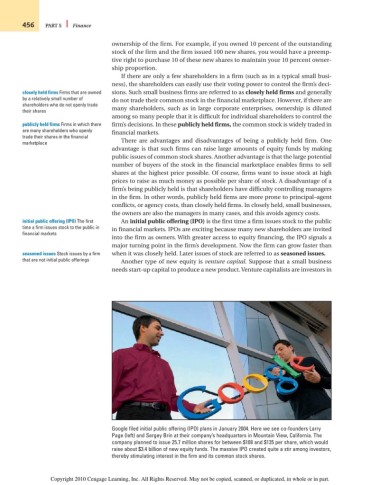Page 482 - Introduction to Business
P. 482
456 PART 5 Finance
ownership of the firm. For example, if you owned 10 percent of the outstanding
stock of the firm and the firm issued 100 new shares, you would have a preemp-
tive right to purchase 10 of these new shares to maintain your 10 percent owner-
ship proportion.
If there are only a few shareholders in a firm (such as in a typical small busi-
ness), the shareholders can easily use their voting power to control the firm’s deci-
closely held firms Firms that are owned sions. Such small business firms are referred to as closely held firms and generally
by a relatively small number of do not trade their common stock in the financial marketplace. However, if there are
shareholders who do not openly trade
their shares many shareholders, such as in large corporate enterprises, ownership is diluted
among so many people that it is difficult for individual shareholders to control the
publicly held firms Firms in which there firm’s decisions. In these publicly held firms, the common stock is widely traded in
are many shareholders who openly financial markets.
trade their shares in the financial
marketplace There are advantages and disadvantages of being a publicly held firm. One
advantage is that such firms can raise large amounts of equity funds by making
public issues of common stock shares. Another advantage is that the large potential
number of buyers of the stock in the financial marketplace enables firms to sell
shares at the highest price possible. Of course, firms want to issue stock at high
prices to raise as much money as possible per share of stock. A disadvantage of a
firm’s being publicly held is that shareholders have difficulty controlling managers
in the firm. In other words, publicly held firms are more prone to principal–agent
conflicts, or agency costs, than closely held firms. In closely held, small businesses,
the owners are also the managers in many cases, and this avoids agency costs.
initial public offering (IPO) The first An initial public offering (IPO) is the first time a firm issues stock to the public
time a firm issues stock to the public in in financial markets. IPOs are exciting because many new shareholders are invited
financial markets
into the firm as owners. With greater access to equity financing, the IPO signals a
major turning point in the firm’s development. Now the firm can grow faster than
seasoned issues Stock issues by a firm when it was closely held. Later issues of stock are referred to as seasoned issues.
that are not initial public offerings Another type of new equity is venture capital. Suppose that a small business
needs start-up capital to produce a new product. Venture capitalists are investors in
Google filed initial public offering (IPO) plans in January 2004. Here we see co-founders Larry
Page (left) and Sergey Brin at their company’s headquarters in Mountain View, California. The
company planned to issue 25.7 million shares for between $108 and $135 per share, which would
raise about $3.4 billion of new equity funds. The massive IPO created quite a stir among investors,
thereby stimulating interest in the firm and its common stock shares.
Copyright 2010 Cengage Learning, Inc. All Rights Reserved. May not be copied, scanned, or duplicated, in whole or in part.

